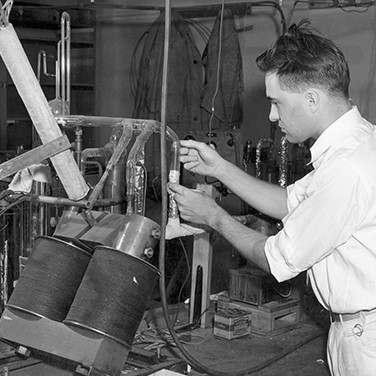Mass Spectrometry: Then and Now
By Kevin Ritchart
Since its inception more than 100 years ago, mass spectrometry (MS) has been an important tool in the study of matter. The concept of isotopes, the determination of atomic weights, the identification of new elements and quantitative gas analysis are just some of the discoveries made possible by the development of MS.
While many people consider MS to be a chemical process, it is actually rooted in physics. As with many scientific discoveries, J.J. Thomson, the man credited as its inventor, was looking for something else. The 28-year-old had received the prestigious Cavendish Professorship and was studying the transmission of electricity through gases at Cambridge University.
In 1897, Thomson’s assistant, E. Everett, built an apparatus to measure the magnetic deflection of cathode rays, which Thomson used to measure the charge-to-mass ratio (known as e/m) of electron particles (e). Two years later, their collaboration resulted in an instrument that could quantify both e/m and e to indirectly measure electrons’ mass.
Award-Winning Work
Thomson’s work earned him the 1906 Nobel Prize for Physics and laid the foundation for further growth. Thomson and Francis Aston (who won the 1922 Nobel Prize for Chemistry) built what is considered to be the first mass spectrometer. To measure the mass of charged atoms, ions were generated by gas discharge tubes. The ions were then passed through parallel electric and magnetic fields, which deflected them into parabolic trajectories, and the results were captured on photographic plates.
Later, Aston and other scientists redesigned the instruments to improve resolution and used them to isolate and prove the existence of elemental isotopes, an understanding that was critical to the development of the atomic bomb by the Manhattan Project during World War II.
By the 1940s, chemists in the petroleum industry began to use MS to measure the levels of small hydrocarbons. Although the technique was well established and mass spectrometers were being commercially produced, the actual process and the best way to leverage the data were not well understood.
Further Development
In the 1960s, chemists began to really understand how complex molecules were fragmented by the instrument, which led to new applications. Three chemists — Fred McLafferty, Klaus Biemann and Carl Djerassi — performed MS experiments with different classes of organic molecules, which gave chemists a way to determine the structures of unknown molecules.
By the 1980s, the use of MS to analyze small organic molecules had become routine. The development of Electro-Spray Ionization (ESI) and Matrix Assisted Laser Desorption Ionization (MALDI) techniques in 1988 revolutionized MS.
Other MS-related techniques include: inductively coupled plasma-MS (ICPMS), accelerator MS (AMS), thermal ionization-MS (TIMS) and spark source MS (SSMS). MS is also commonly used in conjunction with various separation methods like gas chromatography (GC/ MS), liquid chromatography (LC/MS or LC-MS) and ion mobility spectrometry (IMS/MS or IMMS).
With its rich history, future uses for MS may very well be limitless.
